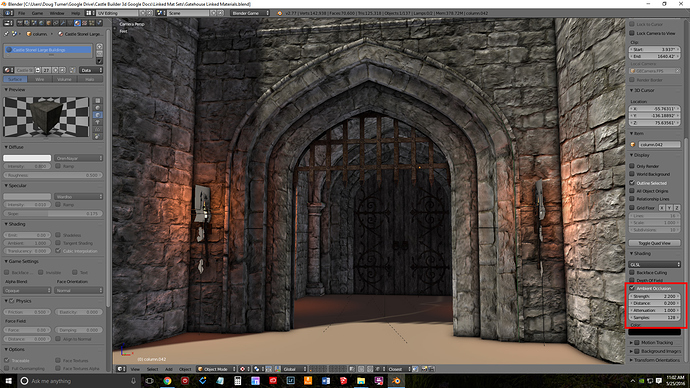I’m using the SSAO script that came with Mike Pan’s Easy Game add on. It is the original Martinsh script, or some version of it. I’d like to modify the script to achieve a stronger feel, as shown in the images. I know nothing of Python, and have played with this script in an attempt to figure it out. I’m just too many hours in, and at this point I’m just wasting time. Help? Thanks.
Image 1 shows the script in game. Image 2 shows Blender’s new built-in ao, which I wish worked in game. I’d like the script to look similar to that setting. Script below.
/*
SSAO GLSL shader v1.2
assembled by Martins Upitis (martinsh) (devlog-martinsh.blogspot.com)
original technique is made by Arkano22 (www.gamedev.net/topic/550699-ssao-no-halo-artifacts/)
*/
uniform sampler2D bgl_DepthTexture;
uniform sampler2D bgl_RenderedTexture;
uniform float bgl_RenderedTextureWidth;
uniform float bgl_RenderedTextureHeight;
uniform float timer;
#define PI 3.14159265
float width = bgl_RenderedTextureWidth; //texture width
float height = bgl_RenderedTextureHeight; //texture height
vec2 texCoord = gl_TexCoord[0].st;
//------------------------------------------
//general stuff
//make sure that these two values are the same for your camera, otherwise distances will be wrong.
float znear = 0.1; //Z-near
float zfar = 100.0; //Z-far
//user variables
int samples = 8; //ao sample count
float radius = 5.0; //ao radius
float aoclamp = 0.25; //depth clamp - reduces haloing at screen edges
bool noise = true; //use noise instead of pattern for sample dithering
float noiseamount = 0.001; //dithering amount
float diffarea = 0.4; //self-shadowing reduction
float gdisplace = 0.4; //gauss bell center
float lumInfluence = 0.5; //how much luminance affects occlusion
//--------------------------------------------------------
vec2 rand(vec2 coord) //generating noise/pattern texture for dithering
{
float noiseX = ((fract(1.0-coord.s*(width/2.0))0.25)+(fract(coord.t(height/2.0))*0.75))2.0-1.0;
float noiseY = ((fract(1.0-coord.s(width/2.0))0.75)+(fract(coord.t(height/2.0))*0.25))*2.0-1.0;
if (noise)
{
noiseX = clamp(fract(sin(dot(coord ,vec2(20.0,46.0*timer))) * 47358.5453),0.0,1.0)2.0-1.0;
noiseY = clamp(fract(sin(dot(coord ,vec2(41.0,37.2timer)*2.0)) * 43758.5453),0.0,1.0)*2.0-1.0;
}
return vec2(noiseX,noiseY)*noiseamount;
}
float readDepth(in vec2 coord)
{
if (gl_TexCoord[0].x<0.0||gl_TexCoord[0].y<0.0) return 1.0;
return (2.0 * znear) / (zfar + znear - texture2D(bgl_DepthTexture, coord ).x * (zfar-znear));
}
float compareDepths(in float depth1, in float depth2,inout int far)
{
float garea = 2.0; //gauss bell width
float diff = (depth1 - depth2)*100.0; //depth difference (0-100)
//reduce left bell width to avoid self-shadowing
if (diff<gdisplace)
{
garea = diffarea;
}else{
far = 1;
}
float gauss = pow(2.7182,-2.0*(diff-gdisplace)(diff-gdisplace)/(gareagarea));
return gauss;
}
float calAO(float depth,float dw, float dh)
{
float dd = (1.0-depth)*radius;
float temp = 0.0;
float temp2 = 0.0;
float coordw = gl_TexCoord[0].x + dwdd;
float coordh = gl_TexCoord[0].y + dhdd;
float coordw2 = gl_TexCoord[0].x - dwdd;
float coordh2 = gl_TexCoord[0].y - dhdd;
vec2 coord = vec2(coordw , coordh);
vec2 coord2 = vec2(coordw2, coordh2);
int far = 0;
temp = compareDepths(depth, readDepth(coord),far);
//DEPTH EXTRAPOLATION:
if (far > 0)
{
temp2 = compareDepths(readDepth(coord2),depth,far);
temp += (1.0-temp)*temp2;
}
return temp;
}
void main(void)
{
vec2 noise = rand(texCoord);
float depth = readDepth(texCoord);
float w = (1.0 / width)/clamp(depth,aoclamp,1.0)+(noise.x*(1.0-noise.x));
float h = (1.0 / height)/clamp(depth,aoclamp,1.0)+(noise.y*(1.0-noise.y));
float pw;
float ph;
float ao;
float dl = PI*(3.0-sqrt(5.0));
float dz = 1.0/float(samples);
float l = 0.0;
float z = 1.0 - dz/2.0;
for (int i = 0; i <= samples; i ++)
{
float r = sqrt(1.0-z);
pw = cos(l)r;
ph = sin(l)r;
ao += calAO(depth,pww,phh);
z = z - dz;
l = l + dl;
}
ao /= float(samples);
ao = 1.0-ao;
vec3 color = texture2D(bgl_RenderedTexture,texCoord).rgb;
vec3 lumcoeff = vec3(0.299,0.587,0.114);
float lum = dot(color.rgb, lumcoeff);
vec3 luminance = vec3(lum, lum, lum);
vec3 final = vec3(colormix(vec3(ao),vec3(1.0),luminancelumInf luence));
gl_FragColor = vec4(final,1.0);
}


